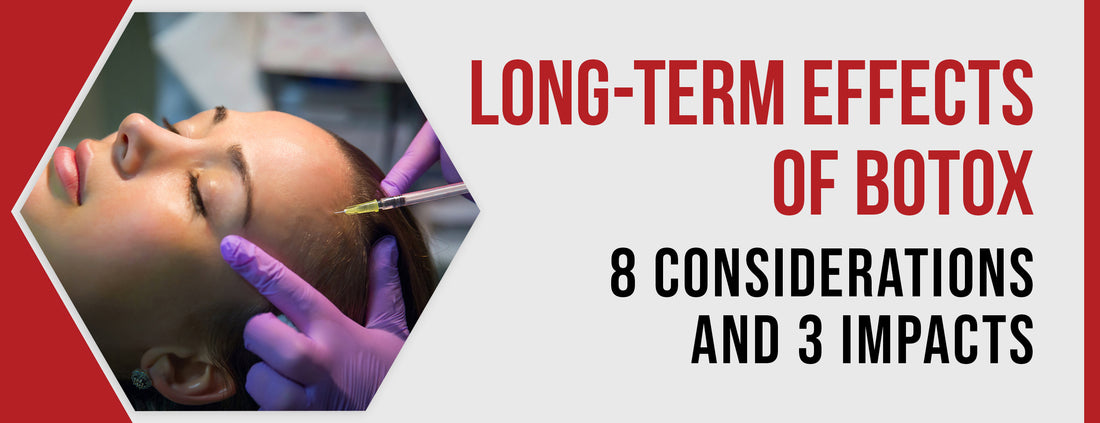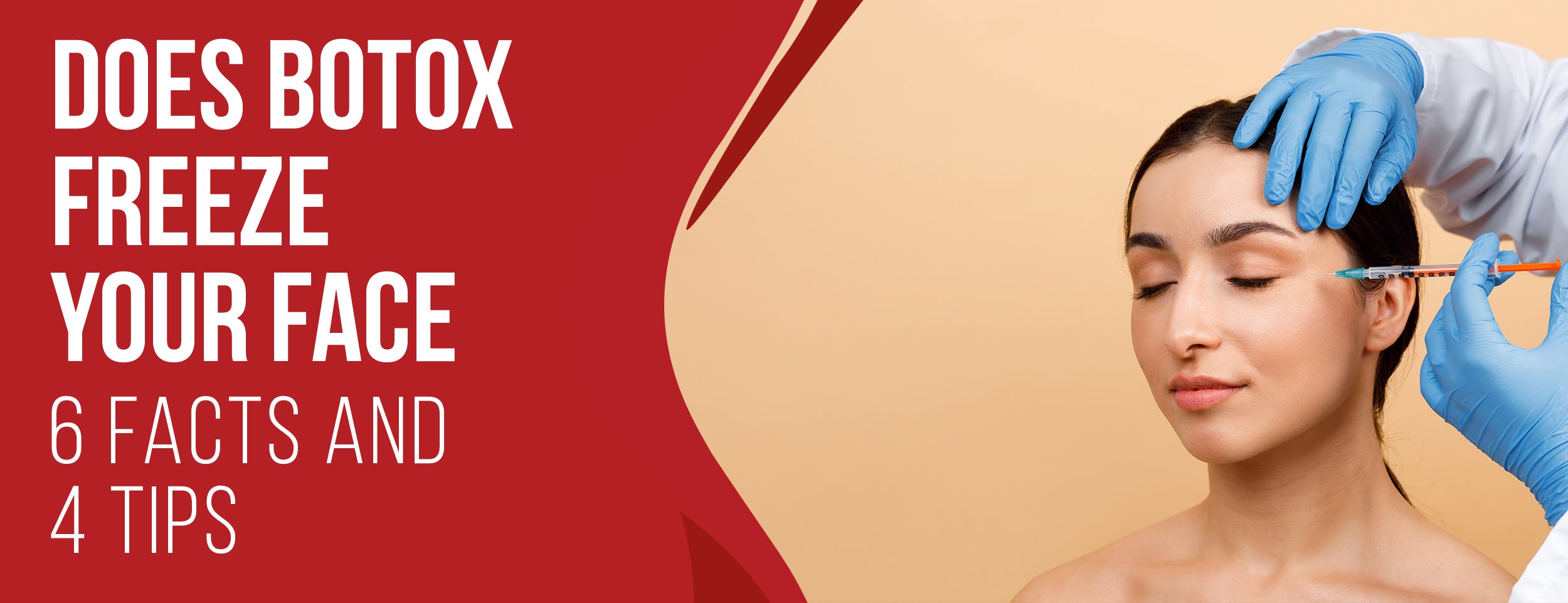It's easy to overlook the long-term impact of Botox treatment. Despite instant and appealing results, it is imperative to study the potential hazards of this procedure before receiving treatment.
Regular usage of Botox can weaken facial muscles, making it hard to convey emotions over time. Excessive usage can even result in a "frozen" appearance and affect confidence.
Thus, caution and an understanding of the potential long-term effects are crucial. The purpose of this blog post is to explore the enduring impact of Botox and the benefits and downsides of continuous usage.
Long-Term Effects of Botox: 8 Important Considerations

If you're contemplating Botox, informing yourself about its long-term effects is crucial. There are eight key considerations:
- Loss of Facial Expressions.
- Muscle Atrophy.
- Resistance to Botox.
- Bruising and Swelling.
- Headache.
- Over-Reliance on Botox.
- Financial Costs.
- Psychological Impacts.
While Botox does deliver several cosmetic benefits, it's essential to consider the potential long-term effects before committing. Always consult a qualified medical professional before undergoing any treatments.
Reduced Frequency of Migraines

Botox is widely known to alleviate migraines by reducing their frequency and severity. This medication blocks the release of certain chemicals in the brain responsible for triggering pain and inflammation, effectively calming overactive nerves.
While the full effects may take some time to become apparent - with some patients seeing improvement within the first few weeks - the results can last several months.
Decreased Sweating and Improved Hygiene
Botox has another trick that can come in handy - combating hyperhidrosis (excessive sweating). Customers who often sweat excessively under their arms, hands, or feet can significantly benefit from this treatment, as it curbs sweat production by glands in those specific regions.
The effects make several people feel more confident and at ease during their daily routines.
Reduced Appearance of Fine Lines and Wrinkles
Botox is most commonly used to diminish fine lines and wrinkles on the face by relaxing the facial muscles. Muscles cannot contract as a result, resulting in wrinkles.

Diminished Jaw Size Due to Paralysis
Botox can slim down and refine the jawline when it appears overly square or obtrusive. The process involves injecting Botox directly into the masseter muscles that regulate chewing, inducing temporary paralysis that reduces the muscle's size over time. This unique solution can create a satisfyingly defined and proportionate jawline.
Reduced Blemishes and Acne Scarring
Botox isn't just for fine lines and wrinkles anymore. It's a versatile treatment that can even help address specific types of acne and scarring. Relaxing the muscles around blemishes can reduce inflammation and promote accelerated healing. Botox can also help treat scars by boosting collagen production in the skin, improving appearance over time.
Improved Overall Skin Condition and Elasticity

Botox can also reduce wrinkles and fine lines, and improve overall skin condition and elasticity. This is because Botox triggers collagen and elastin production, which are essential building blocks for healthy skin. Regular treatments can help to keep skin looking firm, youthful, and radiant.
Reduced Risk of Developing Chronic Migraines
Botox treatments have the potential to not only mitigate the frequency and severity of migraines but also decrease the chance of developing chronic migraines. This is officially considered when someone has 15 or more headache days each month.
Regular injections help keep the nerves from overstimulating and inflamed, minimizing headaches.
Preventing Excessive Sweat Production
Botox has yet another practical application in preventing excessive sweat production. An issue that afflicts many individuals who suffer regular embarrassment and discomfort.
This condition, known as hyperhidrosis, can be effectively treated by temporarily shutting down the sweat glands. So for people struggling with profuse sweating, Botox can bring much-needed relief.
Long-Term Consequences of Over-Use

We are here to discuss the adverse effects of overuse on our bodies. The result could be muscle atrophy, weakness, increased tolerance to treatment, and antibody formation. These long-term consequences can be seriously harmful, so preventing or reducing them is crucial.
Muscle Atrophy and Weakening
One of the most well-known long-term consequences of overusing Botox is muscle atrophy and weakening. Botox works by paralyzing specific facial muscles, which leads to the appearance of smoother skin. Though initially positive, the continual paralysis of muscles over time can trigger muscle weakening and atrophy.
This can result in sagging skin, drooping eyebrows, and vision problems due to weakened muscles controlling eye movement. These effects can sometimes be permanent, impacting the appearance and function of your face permanently.
Formation of Antibodies
Another potential long-term consequence of Botox overuse is the formation of antibodies. Antibodies are the substances that the immune system produces to fight off foreign invaders like bacteria and viruses. Your immune system can sometimes produce antibodies to remove Botox from your body when exposed to it repeatedly.
Over time, antibodies can accumulate, hindering future Botox treatments. Requiring increasingly higher doses of Botox for the same result poses more health risks & side effects.
Increased Tolerance to Treatment

Finally, another consequence of Botox overuse is increased tolerance to treatment. Like any drug, the body can build up resistance to Botox over time. It is necessary to use higher doses to achieve the same effects, leading to frequent and costly injections.
As your tolerance builds, the risk of side effects from Botox also increases. For instance, injecting the same area multiple times can cause tissue damage and scarring, leading to severe and long-lasting issues.
While Botox seems like an effortless solution for combatting wrinkles, evaluating the long-term consequences and potential dangers is crucial.
Long-Term Effects After Stopping Botox
Botox is used to treat wrinkles, but its long-term effects are unclear. If used repeatedly in the same area, it can weaken muscles causing sagging skin. It can also change skin texture in treated areas. Issues like drooping eyelids or difficulty swallowing may occur after long-term use. Scaling back or stopping treatment can reverse most effects. Work with a professional to discuss desired outcomes and follow treatment guidelines to avoid issues.

Reversal of Treatment Results
Stopping Botox treatment can lead to the reversal of the positive results it initially provides. This occurs as the muscles previously paralyzed by the injections regain motion and wrinkles resurface.
Other factors that can impact Botox results include age and lifestyle habits. It's important to note the potential long-term effects of stopping this treatment to make an informed decision.
Return of Wrinkles
Stopping Botox can cause unwelcome long-term effects beyond the return of original wrinkles. When initially taking Botox, it targets the specific muscle movement that causes wrinkles. When injections are discontinued, the muscles regain movement abilities, resulting in the reoccurrence of wrinkles.
In some cases, the skin may even appear worse than before. One should be mindful before starting Botox to avoid reversing treatment results.
Restoring Muscle Function

Finally, it's vital to acknowledge the enduring effects of Botox in restoring muscle function post-discontinuation. Consideration of this effect is crucial in ensuring thorough assessment before use. Botox temporarily paralyzes muscles but regains full position once the effects wear off.
This means that facial expression muscles will recover while wrinkles and fine lines may reappear. Keep in mind that there may also be other essential factors to consider.
Long-Term Botox Brightens Skin and Decreases Wrinkles
The neurotoxin Botox paralyzes facial muscles softens wrinkles, and leaves skin photo-ready. Prolonged use increases collagen production for plump, firm, and healthy skin. It also reduces hyperpigmentation, inflammation, and puffiness for a refreshed, rested appearance.
While it has transformative benefits, consult with a licensed professional due to potential side effects. Give Botox a shot to turn back the clock on pesky wrinkles.
How Can Botox Brighten Skin With Age?
The elasticity of our skin decreases as we age, resulting in a dull and tired appearance. Botox injections offer a solution that will rejuvenate your skin to radiate a youthful glow. Botox targets the muscles under the skin's surface, reducing wrinkles and fine lines by relaxing them.
In addition to the smoothing effect, Botox boosts collagen production, contributing to the skin's texture and brightness. These effects can last for several months, offering a comprehensive solution to combat the signs of aging.
Botox’s Ability to Reduce Fine Lines and Wrinkles

Many people turn to Botox injections to diminish the look of fine lines and wrinkles. The treatment works by relaxing facial muscles, making the skin appear smoother.
Botox blocks nerve signals to the muscles, halting contractions and the subsequent creases in the skin. It lasts for months and is reliable for achieving youthful-looking skin without frequent touch-ups.
Long-Term Positive Effects of Botox on Skin Health
Aside from its cosmetic benefits, Botox can have several positive long-term effects on skin health. Botox injections can improve skin texture, eliminate wrinkles, and promote a more even complexion by increasing collagen production, a crucial protein that maintains skin elasticity and firmness.
Furthermore, the treatment can relieve skin conditions such as rosacea and hyperhidrosis, which causes excessive sweating. Regular Botox injections can assist in managing these conditions, resulting in healthier skin. In summary, Botox's positive long-term effects encompass more than its cosmetic advantages.
Long-Term Effects of Botox on Forehead

The injection of Botox reduces wrinkles on the forehead. Regular use can lead to sagging skin and possible side effects such as muscle drooping, headaches, and allergic reactions.
The Appearance of Forehead Wrinkles Over Time
One of the main benefits of Botox is that it reduces the appearance of forehead wrinkles. Botox's impact on the forehead can vary between individuals. Some people experience smoother skin and fewer wrinkles for several months, while others require injections more frequently to maintain smoothness.
Benefits of Botox Injections for the Forehead
Botox injections offer several benefits when administered on the forehead, like diminishing the look of wrinkles and lines. The mechanism by which it operates involves temporary relaxation of muscles that cause creases, thereby resulting in smoother skin.
Besides reducing wrinkles, botox injections can lift the eyebrows for a youthful appearance. Some individuals even experience enhanced confidence and self-assurance post-botox treatment.
Long-Term Results on the Forehead
The forehead's long-term reaction to Botox varies based on multiple factors, including muscle strength, age, and frequency of injections. While some may achieve a half-year's long-lasting effects with a single treatment, others may require it more frequently to sustain desired results.
It's worth considering that the impact of Botox can fluctuate over time. Consistent injections over multiple years may lead to diminished effects. In such cases, switching to an alternate treatment or augmenting the botox dosage may be necessary.
Botox can bring many people a favorable outcome by reducing the appearance of wrinkles. This can create a youthful and confident look, but it's essential to consult a qualified professional to discuss all aspects of the procedure.
Long-Term Side-Effects of Botox on Face

The long-term effects of Botox can be problematic. They can result in significant changes to your facial appearance. In the following lines, we dive deeper into each of these effects.
Facial Muscle Weakness
Facial muscle weakness is among the most frequent long-term effects of Botox treatments. This is because the toxin effectively immobilizes your facial muscles, which can lead to the gradual loss of muscle tone. Over time, excessive use of Botox can cause a droopy and saggy appearance, which can be distressing for some users.
Dermal Sensitivity Issues
Botox has long-term side effects, including dermal sensitivity issues. Your skin could become sensitive to skin care products and the environment, causing breakouts and redness. Your skin may become more vulnerable to damage, leading to wrinkles and fine lines.

Changes to Facial Expressions
Although botox can help maintain a youthful appearance, it can affect facial expressions. Paralyzing facial muscles can make it harder to move your face naturally with emotions. Thus, your face may appear motionless and bland, and this could hamper personal or professional relations.
Long-Term Results on Facial Appearance
Prolonged use of Botox may negatively impact your appearance. While the treatment's effects are temporary, consistent sessions are necessary. Over time, frequent therapies could result in an unnatural, stiff, or distorted appearance.
Botox isn't suitable for everyone, including individuals with allergies, chronic muscle disorders, pregnant or breastfeeding women, etc. Those who are unable to receive treatment may also experience adverse cosmetic effects.
As we wrap up, it's essential to reflect on the consequences of Botox. While it may offer immediate results, considering the long-term effects is crucial. Understanding the associated risks and seeking advice from a professional on any cosmetic procedure can't be emphasized enough.
Long-Term Effects of Botox Injections for Migraines

Botox injections can reduce migraine frequency and severity by relaxing the head and neck muscles. But, facial appearance, muscle weakness, and injection immunity are possible, and Botox doesn't address the underlying causes of migraines. Seek a healthcare professional's guidance before considering botox treatment.
Long-Term Relief for Chronic Migraine Sufferers

Botox injections offer chronic migraine sufferers enduring relief. In clinical trials, recipients had fewer headache days and less severe symptoms than those receiving a placebo.
The effects last up to three months, granting patients migraine-free spans. Further studies indicate repetitive Botox injections generate even more extended pain relief periods.
Preventing Future Migraines
Botox injections not only treat migraines – they can thwart them, too! By honing in on specific nerve signals that trigger migraines, these injections help break the cycle of chronic headaches. Since 2010, the FDA has approved Botox injections to prevent migraines.
Long-Term Risks and Side-Effects of Botox for Migraines
Botox injections are often used to treat migraines, but there are long-term risks to weigh before pursuing this treatment. For one, injections can sometimes lead to muscle weakness, which limits your ability to perform certain activities.
Some may develop an allergic reaction to the treatment. Worse still, repeated usage of Botox may result in the creation of antibodies, reducing its overall effectiveness.
Conclusion:
Botox may seem harmless and a quick fix for attaining a youthful appearance. Nevertheless, the long-term effects of this treatment have yet to be adequately explored or communicated.
While Botox has benefits, there are crucial downsides, such as muscle atrophy and tension headaches. As with any medical procedure, weighing the pros and cons before committing to long-term use is essential. Always consult a qualified specialist before deciding about your health and beauty routine.











